|
|
LYDIA
c.1000 - 546 BCE
King Lydus of Heraclidae dynasty was the origin for the name Lydia. He was one of the Ionian greeks who ruled the western part of the present day Turkey with Sardis as its capital around 1000 BCE. King Candaules descendent of King Lydus was killed by his bodygaurd Gyges on the orders of the Queen. Thus, the Queen and Kingdom of Lydia was passed into the hands of Gyges. Their son, Ardys (652 - 610 BCE) became the King after Gyges' death. This was the start of Mermnad dynasty. Sadyattes (620 -598 BCE), son of King Ardys ruled Lydia for only a brief period of twelve years. Alyattes (610 - 561 BCE), son of Sadyattes ascended to the Lydian throne and expanded his kingdom. Croesus (561 - 541 BCE), son of King Alyattes was the last king of the Mermnad dynasty of Lydia.
Ionians (greek settlers on the east coast of Asia Minor) described their eastern neighbors Lydians as the people with dark hair and olive colored skin. There was a vigorous trade between the Ionian City States and Lydian Kingdom. Lydian rulers and Ionian city state rulers were also related by marriage. Many historians and archaeologists speculate that increased trade was a spark for invention of the coins. Coins might had facilitated a move from cumbersome barter system of trade to simple system based on the money. Others speculate that they were stuck as offerings to the Gods in their religious ceremonies. Lydian coins found in Ionian mainland temple of Greek goddess Artemis (Roman name - Diana) during archeological excavation in 1951 gives credence to such speculation. Logically, both arguments make sense but we may never know.
Herodotus, the greek historian's writings also tell us that Lydian king Croesus had given great number of coins to the temple at Delphi. Croesus asked advice from the Oracle as to the success of his invasion of Persian kingdom. The Oracle told him that if he crossed the river he would destroy a great kingdom. Encouraged, he proceeded with the invasion. Ironically, Persian King Cyrus the Great won the war in 546 BCE and added Lydian kingdom to his empire. Persian King Cyrus acquired the Lydian mints and technology of making quality coins.
King Ardys
(652-615 BCE)
Herodotus, the greek historian mentions in his writing about crude Lydian coins. First coins of Lydia were lumps of electrum (naturally occurring amalgam of silver & gold). Electurm lumps were found in mountain streams of Lydia. They were heated to soften, placed on a plate and struck with a punch and hammer. This formed an incuse on one side and marked them as coins. These coins were produced at a mint constructed by Lydian King Ardys (652-615 BCE) in the capital city of Sardis. They were not true coins by present day definition because they were not of any standard weight & purity of metal or size.


1/3 Stater coin of Lydia at the time of King Ardys (652-615 BCE)
coin has one square incuse on obverse and rough surface on reverse.
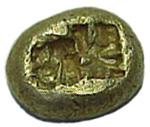
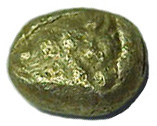
1 Stater coin of electrum of Lydia at the time of King Ardys(652-615
BCE)
Coin has two square incuses on obverse and rough surface on reverse.
King Alyattes
(610-561 BCE)
King of Lydia, Alyattes son of Ardys set a weight standard for the coin (168 grains of wheat for Stater). Advancements in metallurgy at this time created coins using anvil die to make a design on the reverse of the coin. Lion''s head was the symbol of Mermnad dynasty. Standard weight met the second condition to be a true coin.
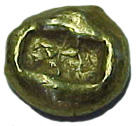
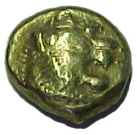
Stater of Lydia at the time of King Alyattes (610-561 BCE)
Two square incuses on obverse and head of a lion on reverse.
King Coresus
( 561-546 BCE )
Credit of producing true coins in Lydia goes to
King Coresus, son of Alyattes. He set the standards for purity of metal
(98 % gold or silver) and official seal of king on the obverse (
head a lion and Bull). This official seal guaranteed the value of the coin
by the King. This met the third condition to be a true coin of the
modern definition.
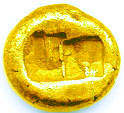
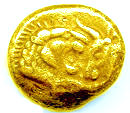
Gold stater of King Coresus ( 561-546 BCE )
Head a lion and bull on reverse and two square incuses on obverse.
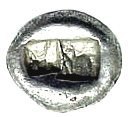
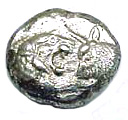
Silver Double Siglos coin of King Coresus ( 561-546 BCE ) .
Head a lion and bull on reverse and two square incuses on obverse.
Head, B. V., The Coinage of Lydia and Persia, 2000.
Previous |
Ancient Country List |
|
|
Index |
|
Home |
|
|